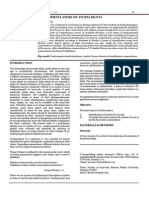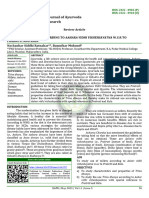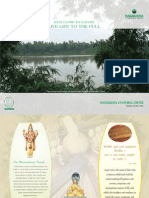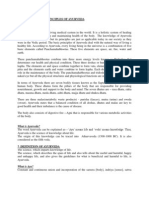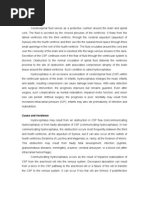Aim of Ayurveda
Aim of Ayurveda
Uploaded by
ravisha7kCopyright:
Available Formats
Aim of Ayurveda
Aim of Ayurveda
Uploaded by
ravisha7kCopyright
Available Formats
Share this document
Did you find this document useful?
Is this content inappropriate?
Copyright:
Available Formats
Aim of Ayurveda
Aim of Ayurveda
Uploaded by
ravisha7kCopyright:
Available Formats
1.1 FUNDAMENTAL PRINCIPLES OF AYURVEDA 1. Principles of Ayurveda Ayurveda is the oldest surviving medical system in the world.
It is a holistic system of healing that focuses on establishing and maintaining health of the body. The knowledge of Ayurveda contained in ancient texts but its principles are just as applicable today in our society as they were in the Vedic period. The basic principles of Ayurveda deal with the natural way of living a healthy life. According to Ayurveda, every living being in the universe is a combination of five basic elements called Panchamahabhootas. These five elements are space, air, fire, water and earth. These panchamahabhootas combine into three more energy levels known as Tridoshas that determines our health and physical condition. These three doshas or humors are vata, pitta and kapha. The elements air and space combine together to form vata, elements fire and water form pitta and the elements earth and water combine to form kapha. Each dosha plays an important role in the maintenance of the body. The panchamahabhootas and tridoshas are not visible to the naked eye but all the physical structures and physiological functions are included in them. In terms of Ayurveda there are seven bodily tissues known as the Sapta Dhatus present in the human body. These dhatus form the pillars of the body that are responsible for providing nourishment, growth and support to the body and mind. The seven dhatus are rasa dhatu, rakta dhatu, masma dhatu, meda dhatu, ashti dhatu, majja dhatu and shukra dhatu. There are three malas(metabolic waste products) - purisha (faeces), mutra (urine) and sweda (sweat). Ayurveda states that a balanced condition of all doshas, dhatus and malas are key to good health and their imbalance is the cause of disease. The body also consists of digestive fire Agni that is responsible for various metabolic activities of the body.
What is Ayurveda? The word Ayurveda can be explained as---Ayu means life and veda means knowledge. Thus, Ayurveda is the science of knowledge about life. The origin of this knowledge can be traced into Atharvaveda (1500-1000 BC). It is also considered as the fifth veda. 2. DEFINITION OF AYURVEDA The science, which imparts knowledge of life. The science, which describes the span of life and also tells about the useful and harmful, happy and unhappy life, and also gives the guidelines for what is beneficial and harmful to life, is Ayurveda. What is Ayu? Constant and continuous union and incorporation of the sareera [body], indriya [sense], satwa
[mind] and atma [soul], is defined as life. Ayu is also referred to as Dhari, Jeevitam, Nithyaga and Anubandha. 3. HISTORY OF AYURVEDA Ayurveda i.e. science of life is eternal and has no beginning or end. Life, intellect, the soul as well as the universe have no beginning or end. Naturally, the science which deals with and has co- existed with life is also eternal. The science of Ayurveda probably originated around 5000 years ago. There is evidance of its continuous practice for more than 2000 years. It is that branch of science which deals with therapy as well as philosophy of living life in a meaningful, healthy and useful way. 4. EVOLUTION OF AYURVEDA:-
Chart 1
Ayurveda avatarana Brahma
Prajapathi
Aswini twins
Indra
Bharadwaj To Arthreya punarvasu, School of Medicine.
Agnivesa, Bhela, Jathukarna, Parasara, Haritha, and Ksharapani
Brahma, remembering Ayurveda (the science of life) taught it to Prajapathi, he inturn taught it to Aswini twins, they taught it to Sahasraksha( Indra). He taught it to Athris son (Arthreya Punarvasu or Krishna Arthreya) and other sages, they taught it to Agnivesa and others and they composed treatises, each one separately. AIM OF AYURVEDA The aim of Ayurveda is two fold.
1. To maintain the health of healthy people 2. To cure the disease of the sick people. i.e. Treatment of diseases. To maintain the health one must follow regularly the principles of Swasthavritta, which includes daily and seasonal regimens, code of good conducts etc. Its purpose in other words is to describe all the methods and means for constantly maintaining a balanced state of TRIDOSHAS (vata, pitha and kapha) i.e. maintenance of homeostasis or balanced state in the body. 6. ASTANGA AYURVEDA (Branches of Ayurveda) Ayurveda has been described in eight branches --1 .Kayachikitsa -General Medicine 2. Kaumarbhritya- Paediatrics including Gynaecology and Obstetrics 3. Bhutavidya- Psychiatry 4. Shalakya- Ophthalmology/ENT 5. Shalya- Surgery 6. Agadatantra- Toxicology 7. Rasayanatantra Rejuvenating medicine 8. Vajeekaranatantra- Improving the fertility/virulity. The other specialization of Ayurveda that have emerged on specialised subjects during the course of evolution of ayurveda includes - Dravyaguna, Bhaishajya Kalpana and Rasashastra. Dravyaguna - Studying about the properties of materials used as medicine . Bhaishajya Kalpanas - Learning the methods of Herbal formulations Rasashastra - knowing about the properties of metals, minerals their purification methods, medicinal values and their preparations. 7. PANCHAMAHABHOOTHAS The 5 Mahabhoothas are 1. Akasha 2. Vayu 3. Agni 4. Ap 5. Prithvi Table 1. Properties of mahabhoothas
Mahabhoota Akasa (space) Vayu (air) Agni (fire) Ap Prithvi
Properties Shabda [Sound] Sparsa [touch] Roopa [Vision] Rasa [Taste] Gandha [Smell]
Characters* non- interruption mobility hotness liquidity Coarseness
Sense organs Ear Skin Eyes Tongue Nose
All these *characters are perceivable by the tactile sense organs because touch along with its absence is known by the tactile sense organ. [C.Sa.1/28-29] Table 2. Relationship of Pancha mahabhootas with dosha & Guna Pancha mahabhoota Vayu + Akasa Agni Prithvi + Ap Dosha Vata Pitha Kapha Gunas Rajas Satwa, Rajas Tamas
8. RASAS Shatrasas Six types of rasa(tastes) are identified. They are 1. 2. 3. 4. 5. 6. Madhura - Sweet Amla - Sour Lavana - Salt Tikta Bitter Katu Pungent Kashaya Astringent
Table 3. Relationship of six rasa with Panchamahabhoothas Rasas Madhura Amla Lavana Tastes Sweet Sour Salt Mahabhuthas Prithvi + Ap Prithvi + tejus Ap + Tejus Examples Milk, Jaggery Lemon, Curd Rock salt, alkali
Tikta Katu Kashaya
Bitter Pungent Astringent
Vayu + Akasa Vayu + Tejus Vayu + Prithvi
Neem, turmeric Ginger, garlic and pepper Tea, Amla
Table 4. Functions of Rasa Madhura Amla Lavana Madhura Tikta Kashya Increase kapha dosha Decrease vata dosha Decrease pitha dosha Tikta Katu Kashaya Katu Amla Lavana Increase vata dosha Decrease Kapha dosha Increase Pitha Dosha
You might also like
- Baby 411Document1,101 pagesBaby 411Raycharles100% (1)
- Pacific Cross: Accredited Providers HospitalsDocument18 pagesPacific Cross: Accredited Providers HospitalsAces Salvador SocitoNo ratings yet
- AnalgesiaDocument551 pagesAnalgesiaMariusNo ratings yet
- Foot & Ankle Surg Complications Seminar: ACFAS Tri-State Region PresentsDocument5 pagesFoot & Ankle Surg Complications Seminar: ACFAS Tri-State Region Presentsbao0% (1)
- The Science of Ayurveda: The Ancient System to Unleash Your Body's Natural Healing PowerFrom EverandThe Science of Ayurveda: The Ancient System to Unleash Your Body's Natural Healing PowerNo ratings yet
- Going Towards the Nature Is Going Towards the Health; Gaining StrengthFrom EverandGoing Towards the Nature Is Going Towards the Health; Gaining StrengthNo ratings yet
- Shalkya TantraDocument3 pagesShalkya Tantratejpat2k7No ratings yet
- Ayurveda VedantaDocument38 pagesAyurveda Vedantavijender AtriNo ratings yet
- Anatomy in Ayurveda (Sharir Rachana) : Description of OrgansDocument6 pagesAnatomy in Ayurveda (Sharir Rachana) : Description of OrgansMinakshi ki creativesNo ratings yet
- Ayurveda - A GlanceDocument15 pagesAyurveda - A GlanceYiru ShiNo ratings yet
- Dravyaguna Vigyan (Materia Medica & Pharmacology) : Maharashtra University of Health Sciences, NashikDocument3 pagesDravyaguna Vigyan (Materia Medica & Pharmacology) : Maharashtra University of Health Sciences, NashikKajal SinghNo ratings yet
- Kavindu Final.Document33 pagesKavindu Final.KavinduKarunarathnaNo ratings yet
- Hypertension in AyurvedaDocument45 pagesHypertension in AyurvedaDrVikasNo ratings yet
- Medicinal Therapies in Veda: Review ArticleDocument6 pagesMedicinal Therapies in Veda: Review ArticleMaheswaran R100% (1)
- Hari Sharma ChapterDocument14 pagesHari Sharma Chapterdynamic2004100% (1)
- Vidarbha Ayurved CollegeDocument20 pagesVidarbha Ayurved CollegeyanpallewarNo ratings yet
- Swasthavritta Syllabus: SL No Topic Domain TimeDocument25 pagesSwasthavritta Syllabus: SL No Topic Domain TimeJyotiranjan MeherNo ratings yet
- Katishoola LumbagoDocument4 pagesKatishoola LumbagoRajiv SharmaNo ratings yet
- Importance of Ayurveda SharirDocument7 pagesImportance of Ayurveda SharirHitesh LonareNo ratings yet
- Panchasama ChurnaDocument4 pagesPanchasama Churnadrsa2No ratings yet
- Ayurveda MD Panchakarma Academics DissertationDocument38 pagesAyurveda MD Panchakarma Academics DissertationManish KubawatNo ratings yet
- 1 Introduction To Panchakarma - DR P K V Anand - PpsDocument92 pages1 Introduction To Panchakarma - DR P K V Anand - PpsSunil SutharNo ratings yet
- Concept of Psychosomatic Disorders in Ayurveda PDFDocument5 pagesConcept of Psychosomatic Disorders in Ayurveda PDFNinaBudziszewskaNo ratings yet
- Nasya Karma in Relation To Anidra W.S.R To InsomniaDocument4 pagesNasya Karma in Relation To Anidra W.S.R To InsomniaEditor IJTSRDNo ratings yet
- Review Rasa SindhuraDocument9 pagesReview Rasa SindhuraNCSASTRONo ratings yet
- Managementof Ardhavabhedaka Through PanchakarmaDocument7 pagesManagementof Ardhavabhedaka Through PanchakarmaPNo ratings yet
- Free 1 Year Varmam-Marma Online Retreat Program From VKRCDocument6 pagesFree 1 Year Varmam-Marma Online Retreat Program From VKRCVarmam Academy SriNo ratings yet
- Sesame in MedicineDocument24 pagesSesame in MedicineAnonymous wnVzj20% (1)
- Vipaka CharakaDocument33 pagesVipaka CharakaPreetiNo ratings yet
- Hidden Asana: The Asana Before The ADocument6 pagesHidden Asana: The Asana Before The AAnthonyNo ratings yet
- Brahma Kamal SDocument169 pagesBrahma Kamal SAkshayKatpatalNo ratings yet
- Bams Curriculum 1Document100 pagesBams Curriculum 1Sandeep Singh100% (1)
- Ayurvedic Approach of Prakriti & Its Effect On Lifestyle DisorderDocument5 pagesAyurvedic Approach of Prakriti & Its Effect On Lifestyle DisorderSreedhar TirunagariNo ratings yet
- Dravya Guna 2Document8 pagesDravya Guna 2chauhan_892277982No ratings yet
- 43 48 PDFDocument6 pages43 48 PDFChandu KanthNo ratings yet
- Basti PowerDocument113 pagesBasti PowerMaharshi ShrimaliNo ratings yet
- 3 Rasashastra Bhaishajya KalpanaDocument9 pages3 Rasashastra Bhaishajya Kalpanakartik yadavNo ratings yet
- Physiological Study of Trayopasthambha (Ahara, Nidra Evam Brahmacharya) W.S.R. To Nidra (Sleep)Document11 pagesPhysiological Study of Trayopasthambha (Ahara, Nidra Evam Brahmacharya) W.S.R. To Nidra (Sleep)IJRASETPublicationsNo ratings yet
- Suvarnaprashana Therapy in Children ConcDocument3 pagesSuvarnaprashana Therapy in Children ConcBhavana GangurdeNo ratings yet
- Nishakathakadi Kashaya An Analysis: DR - Sreekala.V.K 1 PG RasasastraDocument63 pagesNishakathakadi Kashaya An Analysis: DR - Sreekala.V.K 1 PG RasasastraSreekala Ajesh100% (1)
- BhaishajyaDocument28 pagesBhaishajyadrsa2No ratings yet
- Ayurvedic Marma Prana Point SystemDocument3 pagesAyurvedic Marma Prana Point SystemДневна Доза ФејсбукаNo ratings yet
- Sarvanga AbhyangaDocument6 pagesSarvanga AbhyangaNatseenNo ratings yet
- Article 1504514230 PDFDocument3 pagesArticle 1504514230 PDFKaushik KumarNo ratings yet
- Assessment of Vata DoshaDocument11 pagesAssessment of Vata DoshaRajendra DeshpandeNo ratings yet
- Ayurveda in Various DiseasesDocument4 pagesAyurveda in Various DiseasesPranab ChoudhuryNo ratings yet
- Basics of Ayurvedic Pharmacology (Dravya Guna Vignana)Document3 pagesBasics of Ayurvedic Pharmacology (Dravya Guna Vignana)SN Wijesinhe100% (1)
- Asava and ArishtaDocument7 pagesAsava and Arishtadrsa2No ratings yet
- The Concept of PrakritiDocument9 pagesThe Concept of Prakritiakshay239No ratings yet
- Concept of Sarira Gunas Archana A RDocument149 pagesConcept of Sarira Gunas Archana A RAndrey Golovinov100% (1)
- Nomenclature of Anukta DravyaDocument7 pagesNomenclature of Anukta DravyaamishcarNo ratings yet
- Ayurveda Case Sheet SampleDocument14 pagesAyurveda Case Sheet SampleDrMohamed Rifas0% (1)
- Yoga: The Original Mind Body MedicineDocument5 pagesYoga: The Original Mind Body MedicineMARCO GUTZNo ratings yet
- Ahamkara in Relation To AyurvedaDocument2 pagesAhamkara in Relation To AyurvedaScott Gerson100% (1)
- Use of Trina Dhanya According To Aahara Vidhi VishDocument4 pagesUse of Trina Dhanya According To Aahara Vidhi Vishumapati 1505No ratings yet
- Ayurveda and Sports MedicineDocument21 pagesAyurveda and Sports MedicineProma Chakraborty100% (2)
- Live Life To The Full: Stay Close To NatureDocument12 pagesLive Life To The Full: Stay Close To NatureSachin TrambadiyaNo ratings yet
- Marma For Class 1Document31 pagesMarma For Class 1sree shynyNo ratings yet
- AyurvedaDocument32 pagesAyurvedaRajeswari RanganathanNo ratings yet
- International Journal of Research in Indian Medicine: Ahara Vidhi - The Ayurvedic Dietary ConceptsDocument7 pagesInternational Journal of Research in Indian Medicine: Ahara Vidhi - The Ayurvedic Dietary ConceptsAleksandr N ValentinaNo ratings yet
- Brihat Dadimashtaka ChurnaDocument6 pagesBrihat Dadimashtaka ChurnaSamhitha Ayurvedic Chennai100% (1)
- Curriculum BAMSDocument59 pagesCurriculum BAMSSamhitha Ayurvedic ChennaiNo ratings yet
- Preparation of Oil in AyurvedaDocument4 pagesPreparation of Oil in Ayurvedaravisha7k0% (1)
- Preparation of Oil in AyurvedaDocument4 pagesPreparation of Oil in Ayurvedaravisha7k0% (1)
- 2 Herbal Prepartion For Primary Health CareDocument3 pages2 Herbal Prepartion For Primary Health Careravisha7kNo ratings yet
- Om Prubhu ShantiDocument4 pagesOm Prubhu Shantiravisha7kNo ratings yet
- Fundamental Principles of AyurvedaDocument2 pagesFundamental Principles of Ayurvedaravisha7kNo ratings yet
- God Hayagriva - The Avatar of Lord Vishnu: Picture CollectionDocument4 pagesGod Hayagriva - The Avatar of Lord Vishnu: Picture Collectionravisha7kNo ratings yet
- Hayagriva Lord VishnuDocument2 pagesHayagriva Lord Vishnuravisha7kNo ratings yet
- Hayagriva The Incarnation of VishnuDocument1 pageHayagriva The Incarnation of Vishnuravisha7kNo ratings yet
- Hayagriva Lord VishnuDocument4 pagesHayagriva Lord Vishnuravisha7kNo ratings yet
- HayagriivamupaasmaheDocument1 pageHayagriivamupaasmaheravisha7kNo ratings yet
- Achondroplasia: A Comprehensive Clinical ReviewDocument49 pagesAchondroplasia: A Comprehensive Clinical ReviewdeviraNo ratings yet
- Approved by The Board of Management of The Postgraduate Institute of Medicine of Sri Lanka University of ColomboDocument24 pagesApproved by The Board of Management of The Postgraduate Institute of Medicine of Sri Lanka University of ColombohackermikeNo ratings yet
- Cardio Pulmonary Resuscitation MODULDocument6 pagesCardio Pulmonary Resuscitation MODULRahman Al-kahfi ArdiansyahNo ratings yet
- Water Deprivation TestDocument5 pagesWater Deprivation TestGhada ElhassanNo ratings yet
- Antibiotics: Use and Misuse in Pediatric Dentistry - A ReviewDocument23 pagesAntibiotics: Use and Misuse in Pediatric Dentistry - A ReviewKarishma SirimullaNo ratings yet
- Position Paper Who ChinaDocument2 pagesPosition Paper Who Chinaapi-307248240No ratings yet
- Food AllergiesDocument4 pagesFood AllergiesfranosullivanNo ratings yet
- Factors Affecting The Performance of 5 Cerebral.10 PDFDocument11 pagesFactors Affecting The Performance of 5 Cerebral.10 PDFRaluca LNo ratings yet
- Parts of Epidemiological StudiesDocument4 pagesParts of Epidemiological StudiesRheign Grace MaandigNo ratings yet
- Role of Pediatric NurseDocument11 pagesRole of Pediatric NurseSapna thakur100% (5)
- Sensory Processing Challenges in ChildrenDocument7 pagesSensory Processing Challenges in ChildrenAldoNo ratings yet
- SHT Medical Terminology (190908)Document53 pagesSHT Medical Terminology (190908)Dewi Putri Lenggo GeniNo ratings yet
- SOAP Handout 2010Document4 pagesSOAP Handout 2010wawanNo ratings yet
- 2017 Article 531Document7 pages2017 Article 531dinimusmanNo ratings yet
- HMC Corporate BrochureDocument37 pagesHMC Corporate BrochureashankarNo ratings yet
- CSS Form 2016 PDFDocument1 pageCSS Form 2016 PDFikenxhee liNo ratings yet
- Jeffrey M. Samuel, Pharm.D., MPHC: Education & Post-Graduate TrainingDocument8 pagesJeffrey M. Samuel, Pharm.D., MPHC: Education & Post-Graduate Trainingapi-606213782No ratings yet
- Platelet Rich FibrinDocument7 pagesPlatelet Rich FibrinNelly AndriescuNo ratings yet
- Ficha Tecnica Test de StereopsisDocument2 pagesFicha Tecnica Test de StereopsisJennifer Andrea PardoNo ratings yet
- The Neer Classification System For Proximal Humeral Fractures.Document7 pagesThe Neer Classification System For Proximal Humeral Fractures.Lim Leng HoiNo ratings yet
- Principles of Tissue Biopsy in Oral and MaxillofacialDocument34 pagesPrinciples of Tissue Biopsy in Oral and MaxillofacialEdmond Apriza DrgNo ratings yet
- HydrocephalusDocument15 pagesHydrocephalusAdela Lhuz100% (3)
- Pagesource PuerperiumDocument76 pagesPagesource PuerperiumLouie BelloNo ratings yet
- Riem Badr, MD, FCAP Named Chief of Pathology and Laboratory ServicesDocument2 pagesRiem Badr, MD, FCAP Named Chief of Pathology and Laboratory ServicesPR.comNo ratings yet
- Dialogue, Medical HistoryDocument2 pagesDialogue, Medical HistoryGerardoUNo ratings yet
- Printable Apgar Score Chart PDF - Google SearchDocument4 pagesPrintable Apgar Score Chart PDF - Google SearchgladyannNo ratings yet



















































